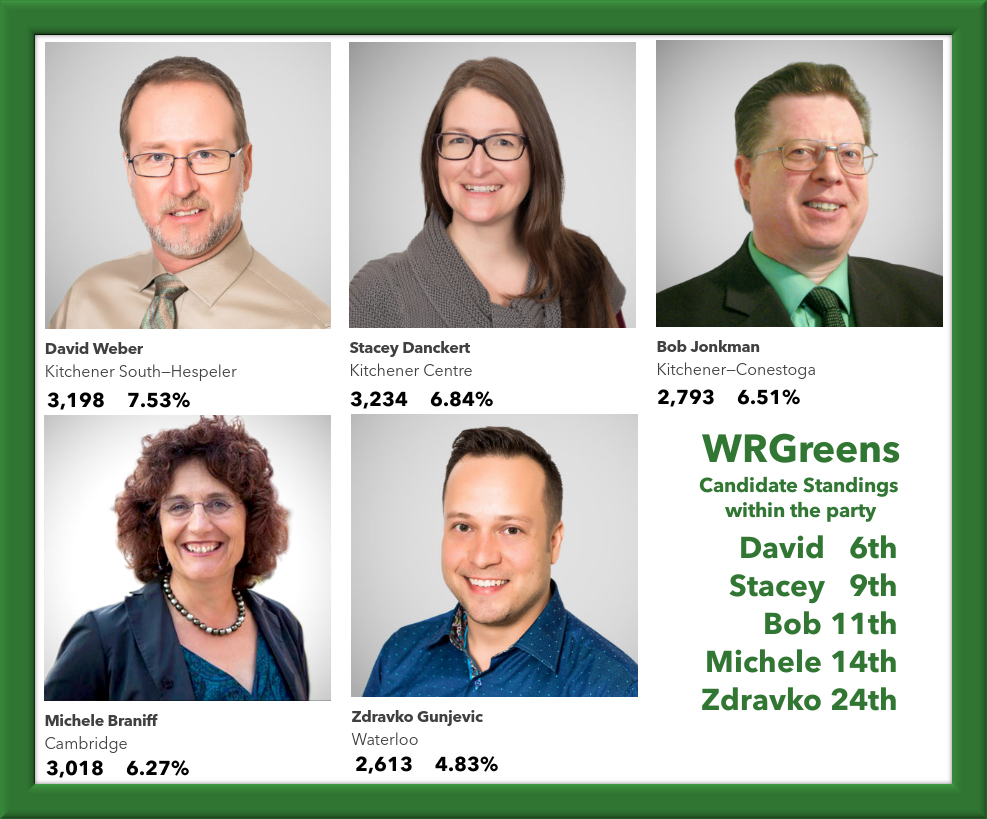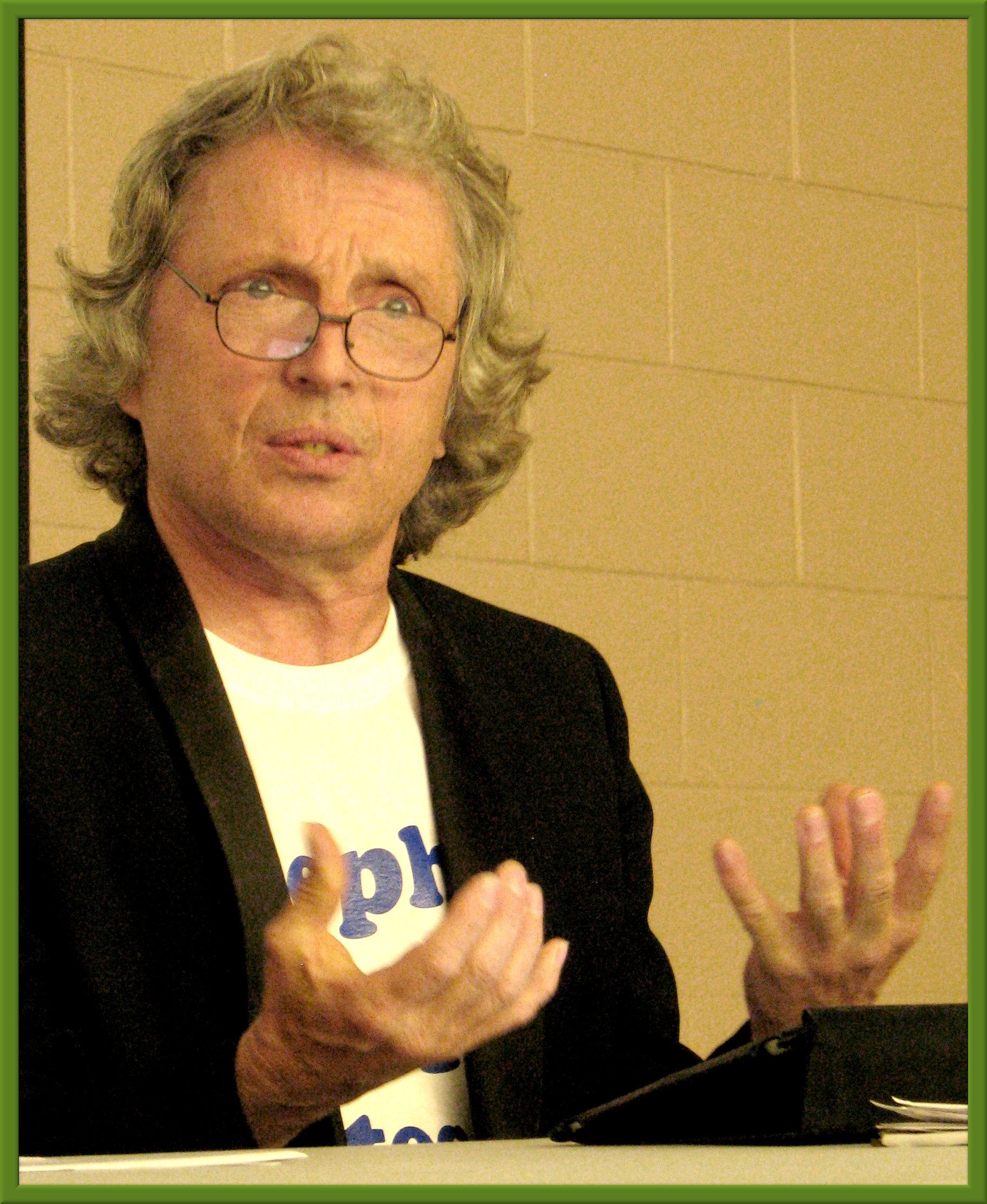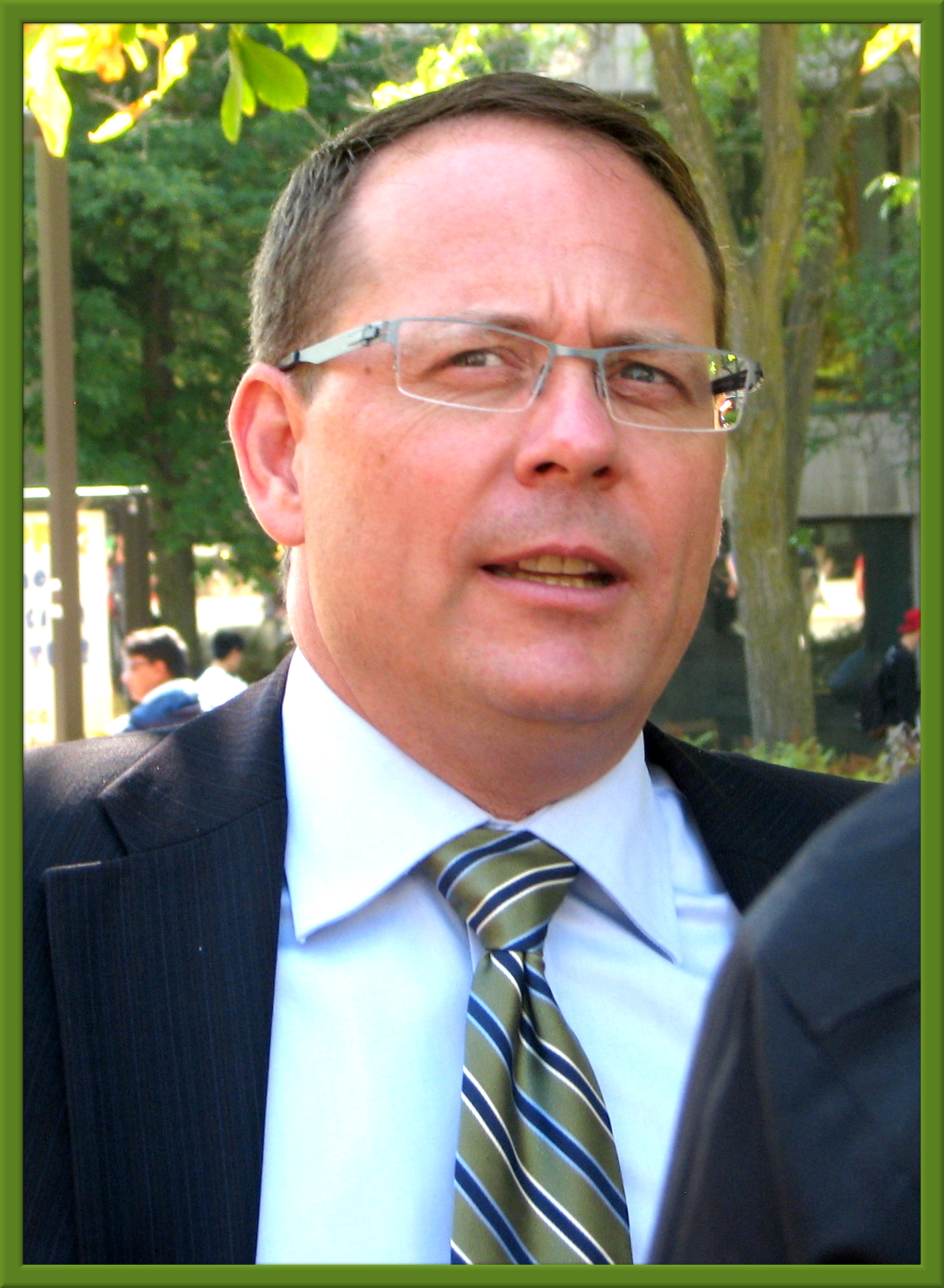Since becoming personally involved in elections, I’ve found myself watching televised election coverage on Election Night. This year, that was at Ethel’s Lounge in Waterloo with three of our 5 Waterloo Region Greens Candidates and WRGreens volunteers and supporters.
Each broadcaster concentrates on the ridings their partisan experts consider important, instead of showing the riding results equally, so it’s hit or miss for all the rest. We chose to watch TVO’s coverage that night at Ethel’s, as TVO was the only MSM broadcaster to include a Green leaning commentator.
At the end of the day, it’s hard to get the big picture. So for my own interest, I decided to check out Elections Ontario (unofficial results) to get an idea how our Green Candidates did overall. Although I did this for my own interest, Bob pointed out this might be of interest to others, so here it is.


 (note: the above all candidates image is actually in three pieces, part 1 is the first 6 rows, part 2 the next 5 rows, and part 3 the last 5 rows. Click on the section you want to see the segment at full size.)
(note: the above all candidates image is actually in three pieces, part 1 is the first 6 rows, part 2 the next 5 rows, and part 3 the last 5 rows. Click on the section you want to see the segment at full size.)
All five of our Waterloo Region Greens candidates did very well overall.
Kitchener South—Hespeler candidate David Weber‘s 7.53 riding vote percentage was the 6th highest in Ontario (up from 7th in 2014). Kitchener Centre‘s candidate Stacey Danckert ranked 9th with 6.84%, Kitchener—Conestoga candidate Bob Jonkman ranked 11th with 6.51%, Cambridge candidate Michele Braniff ranked 14th with 6.27%, and first time candidate Zdravko Gunjevic ranked 24th with 4.83% in Waterloo.
And while I know from personal experience how lucky Waterloo Region has been to have such an excellent roster of WRGreens candidates, I have met enough other Green Party Candidates to know this isn’t really unusual. Frankly, I am continually stunned by the calibre of Green Party Candidates in general. Although the Green Party has far and away the best policy of any of the top four parties, putting your hat in the ring requires a great deal of time, money and effort for any candidate. It’s a big personal investment no matter which party a candidate is running for, and Greens are faced with additional handicaps:
- an electoral system that discriminates egregiously against the Greens,
- unrelenting propaganda that insists majority government is a good thing,
- the exclusion of the Green Party Leader in televised Leaders Debates
- the MSM agenda to keep us perpetually cycling between red and blue parties,
- the never ending push for strategic voting,
- the catch 22 perception that no seats in the legislature means Greens are unelectable, and
- the low probability of winning, even when you are the best candidate in your riding.
Green Candidates are well aware of how little chance they have of being elected, but in spite of everything, excellent Green Party Candidates keep stepping up.
Working together is the WRGreens superpower.
Stacey Danckert brought us all together under the unofficial WRGreens umbrella during the 2015 federal election, and our regional cooperation is paying off. Cooperating, sharing our experience and resources has been incredibly helpful for us here in Waterloo Region.
And not just during elections. We’ve been actively working to raise the Green profile between elections, by hosting information tables at local summer festivals where we can, hosting our own events and participating in others as appropriate, and building our online presence on the WRGreens blog. We’re always learning, and we’ll do it even better next time. Especially now that Mike Schreiner has won that so important first seat.
Strategic Voting is a only a good strategy for the candidate who gets the vote we would rather cast elsewhere.
I know how hard it can be to stay positive, and to keep focus on the campaign. But after media suppression, I think our worst threat is falling prey to propaganda.
The strategic voting narrative continues to be powerful, and it is always the worst when it strikes from within.
In many ways I think this is especially difficult for Greens, because Greens are the unparty party, the party that applauds other parties when they appropriate our ideas, even when implemented badly, because it’s a start.
The stakes are so high that sometimes a candidate falls victim to strategic voting propaganda, and suggests their supporters vote instead for a competitor who might win against a greater evil. This really isn’t surprising in a party that understands the importance of working together for the common good. Green Candidates aren’t professional politicians, they’re people from all walks of life who get involved because they understand our future is at stake and change is no longer optional. They’re in this because serious issues that need to be addressed, not for the greater glory of the party.
One of the reasons strategic voting is wrong is that it is always built on the faulty premise that old statistics— whether gleaned from past elections or recent opinion polls— can accurately predict who might win. If this were true, there would be no need for the trouble and expense of elections.
In this campaign, I was particularly unhappy to see a terrible strategic voting meme initiated by Meanwhile In Canada. The post in question actually told voters to vote NDP except in 5 cases, where it said voters should vote Green because Green candidates could win in those 5 ridings. Some Green folk helped spread this meme thinking it might help change the perception that Green candidates couldn’t win.
I don’t know what exactly that prediction was based on, but two of the candidates who went on to rank in the top 5 percentages in their ridings were excluded from the 5 supposedly winnable ridings. We will never know how many more votes those candidates (or all the Green candidates MiC strategically dismissed) might have won if that social media maven hadn’t been telling voters to vote against Greens in the last week of the campaign.
Although there are no scientific studies of which I am aware, I think Strategic Voting is the most powerful vote suppression tool going. When people are convinced their vote won’t have any effect, or worse, that it will help elect the boogeyman provided by our FPTP system, many feel the only responsible choice is not voting.
We only get one vote. That’s not a vote for a party. It’s not a vote for a party leader. It’s a vote for our local representative. I have to wonder how much better Greens would do in elections if they didn’t have to spend half the election explaining what’s wrong with Strategic Voting.
Since I’m sharing rankings, here are the GPO Top 5:
Green Party of Ontario Leader, and Guelph MPP candidate Mike Schreiner‘s 45.04% riding vote percentage was the highest in Ontario. This resulted in the first seat in the Legislative Assembly of Ontario won by an Ontario Green Party Candidate. Parry Sound—Muskoka‘s candidate Matt Richter ranks 2nd with 20.02%. Laura Campbell ‘s 12.53% of the vote won in Dufferin—Caledon placed her in 3rd position; Barrie—Springwater—Oro—Medonte candidate Keenan Aylwin’s 11.72% of the vote ranks him 4th, and Dave Rodgers 8.64% in Wellington—Halton Hills makes him the 5th highest ranking Ontario Green candidate by percentage.
The Green Party of Ontario is making history, and these five candidates are leading the way forward. Onward!
[Republished from the KitCon Blog’s “Statistics”]



 How much does water cost?
How much does water cost?
